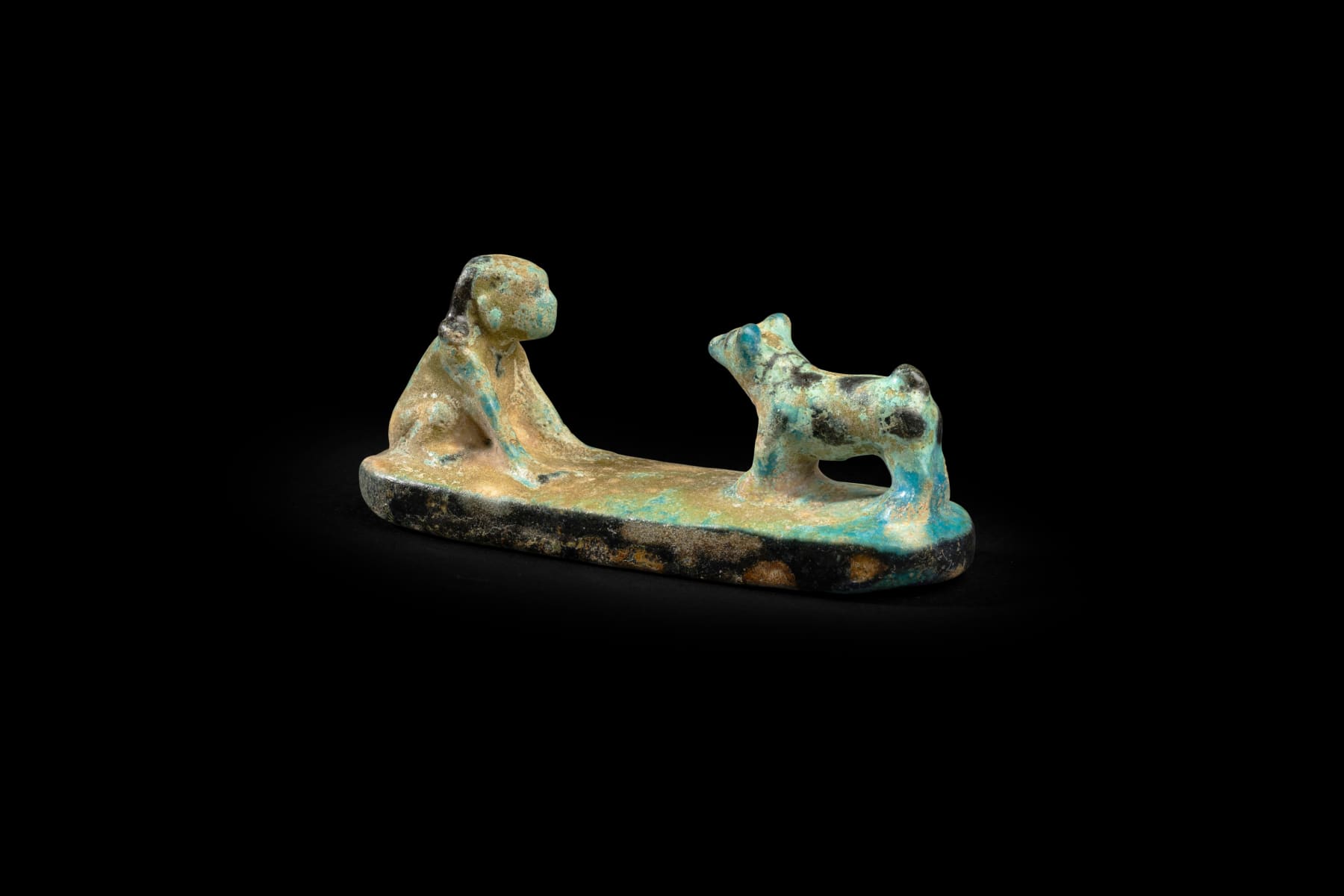Egyptian
An Egyptian faience group of a boy with a dog, Middle Kingdom, 12th Dynasty, circa 1991 - 1783 BC
Faience
Length: 9.5 cm
This small but charming genre scene depicts a naked boy with a sidelock of youth, crouching at the end of an oblong base, in front of a small dog standing...
This small but charming genre scene depicts a naked boy with a sidelock of youth, crouching at the end of an oblong base, in front of a small dog standing foursquare at the other end of the base opposite the boy, the two looking directly at each other with the boys arms stretched in front coaxing the dog towards him. Set on an integral base, all in a turquoise glazed (faded in places to green) faience with dark blue/black glazed details including the child's hair, fingernails and toenails, and the spots and collar of the dog.
Provenance
Norbert Schimmel (1904 - 1990) Collection, New York, acquired before 1964Sotheby’s New York, Important Antiquities from the Norbert Schimmel Collection, 16 December 1992, lot 79
With Galerie Nefer, Zurich, Switzerland, acquired from the above
Private collection, Switzerland
Exhibitions
Fogg Art Museum of Harvard University, The Beauty of Ancient Art, 15 November 1964 - 14 February 1965Israel Museum, Jerusalem, Spertus Hall, 1977
Ägyptisches Museum Berlin, Von Troja Bis Amarna, 18 March - 28 May 1978
Museum für Kunst und Gewerbe Hamburg, 24 June - 3 September 1978
Museum für Vor- und Frühgeschichte München, 28 September 1978 - 6 January 1979
Antikenmuseum Basel, Ägypten – Augenblicke der Ewigkeit. Unbekannte Schätze aus Schweizer Privatbesitz, 18 March - 13 July 1997
Musée d’Art et d’Histoire, Genève (Musée Rath), 26 September 1997 - 11 January 1998
Antikenmuseum Basel, on loan 1998 - 2022
Literature
Faience depictions of animals appear in Egypt from prehistory onwards and include hippopotamuses, lions, monkeys, calves, dogs, hares, and hedgehogs. Thought to have amuletic and protective functions, by the Middle Kingdom, such figurines appear more frequently in tomb deposits.Charming sculptural groups of dogs with their owners are rare but survive in faience (like this example), limestone, and clay, and all date to the Middle Kingdom. For a related 12th dynasty faience example from Lisht, (in The Metropolitan Museum of Art, New York, acc. no. 24.1.46) see the description by W.C. Hayes, Scepter of Egypt I, Cambridge, Mass., 1953, p. 223. There is also another fragmentary example from the Pyramid Complex of Senwosret I at Lisht with a similar squatting figure at one end of a base, and the remains of a four-legged animal (dog or hippo?) at the other end: D. Arnold, The Pyramid Complex of Senwosret I, 1992, p. 61-2, no. 52, pl. 75, 52.
Possibly such groups had a symbolic meaning, providing a watchdog or treasured pet to accompany you in the afterlife. The collar on many of these examples indicates that they were indeed household pets. A number of similar single dog figures have also been found at Lisht, dating to the Middle Kingdom, for example cf. F. D. Friedman (ed.), Gifts of the Nile, London, 1998, p. 129, no. 97 for a similar faience dog in the Staatliche Museen zu Berlin acc. no. 15254. It is possible that these too were once parts of genre groups but have since lost their bases.
For further comparanda cf. J. Garstang, Burial Customs, London, 1907, p. 146, fig. 144; M. Page-Gasser, A. B. Wiese, Ägypten, Augenblicke der Ewigkeit, Mainz, 1997, pp. 87-88, no. 53.
Publications
H. Hoffman (ed.), The Beauty of Ancient Art, The Norbert Schimmel Collection, Mainz, 1964, no. 87O.W. Muscarella (ed.), Ancient Art. The Norbert Schimmel Collection, Mainz, 1974, no. 173
J. Settgast, Von Troja bis Amarna. The Norbert Schimmel Collection, Mainz, 1978, no. 202
M. Page-Gasser, A. Wiese, Ägypten. Augenblicke der Ewigkeit, Mainz, 1997, no. 54
A. Wiese, Antikenmuseum Basel und Sammlung Ludwig. Die Ägyptische Abteilung, 2001, no. 37
6
of
6



